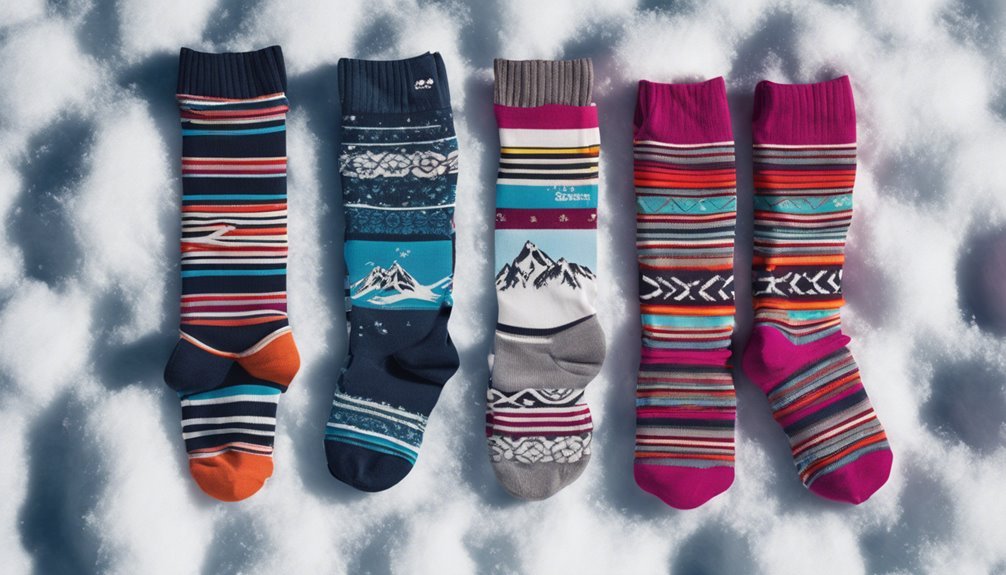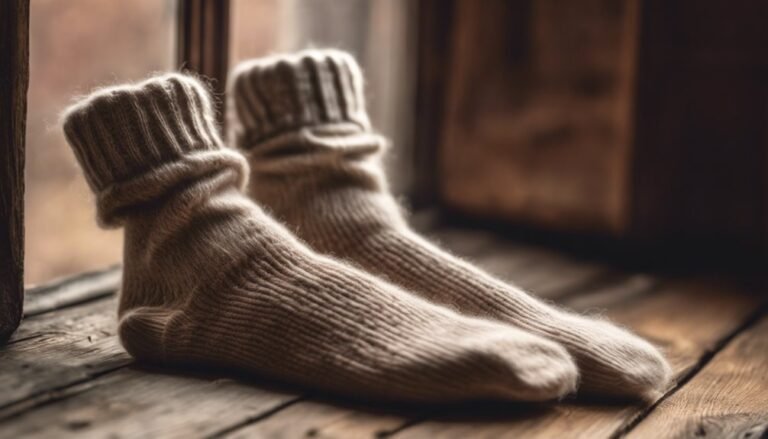Ski Socks vs. Snowboard Socks: Are They Really Different?
Yes, ski socks and snowboard socks are definitely different. Ski socks focus on moisture-wicking, cushioning, and a snug fit for enhanced performance, while snowboard socks offer thicker padding for impact protection and greater warmth. The materials and thickness vary, affecting comfort and temperature regulation during your ride. Choosing the right sock is essential to support your activity and keep your feet comfortable. Keep exploring to discover more about selecting the perfect socks for your snowy adventures.
Understanding the Purpose of Ski Socks

While you might think any pair of socks will do for skiing, understanding the specific purpose of ski socks is essential for an enjoyable experience on the slopes. Ski socks are designed with particular sock materials, such as merino wool or synthetic blends, that provide excellent moisture-wicking properties. This is vital for temperature regulation, keeping your feet warm without overheating. The right sock thickness also helps cushion your feet and reduces friction, preventing blisters. Additionally, ski socks often feature arch support and compression zones to enhance circulation and comfort during long days on the mountain. By choosing the right ski socks, you're not just protecting your feet; you're ensuring that every run feels as liberating as it should be.
Understanding the Purpose of Snowboard Socks
Ski socks and snowboard socks may seem similar at first glance, but they serve distinct purposes tailored to the specific needs of each sport. Snowboard socks are designed to enhance your comfort and performance while riding. They typically use specialized snowboard sock materials, such as merino wool or synthetic blends, which wick moisture and provide insulation. The thickness of snowboard socks plays a significant role too; thicker socks offer additional cushioning, protecting your feet during impact while ensuring a snug fit in your boots. This combination of materials and thickness creates a perfect balance of warmth, breathability, and support, allowing you to focus on enjoying the freedom of carving down the mountain without worrying about discomfort or cold feet.
Key Features of Ski Socks
When choosing ski socks, you'll want to focus on key features that enhance your experience on the slopes. Look for options with adequate padding and support to protect your feet and improve comfort, along with moisture management technology to keep them dry. Additionally, the right height and fit are essential for preventing blisters and ensuring peak performance.
Padding and Support
Three key features set ski socks apart from regular socks: padding, support, and moisture-wicking properties. When it comes to padding types, ski socks often include targeted cushioning in high-impact areas like the shin and footbed, enhancing comfort during long runs. This specialized padding absorbs shock and reduces fatigue, allowing you to focus on your ride. Support levels are equally important; ski socks provide arch support and reinforced zones to stabilize your feet, promoting better control and responsiveness. This added support helps prevent blisters and guarantees a snug fit within your boots. Ultimately, the right combination of padding and support can elevate your skiing experience, giving you the freedom to conquer the slopes with confidence and comfort.
Moisture Management Technology
Moisture management is essential for maintaining comfort on the slopes, and ski socks are engineered with advanced technology to keep your feet dry. These socks feature moisture-wicking materials that draw sweat away from your skin, preventing dampness that can lead to discomfort and cold feet. With effective temperature regulation, they help maintain an ideal environment for your feet, regardless of the weather conditions. This not only enhances your performance but also allows you to focus on enjoying your time on the mountain. The combination of breathability and insulation guarantees that you won't overheat or chill, giving you the freedom to explore without distraction. Invest in quality ski socks to elevate your experience and conquer the slopes with confidence.
Height and Fit
Choosing the right height and fit for your ski socks can greatly impact your comfort and performance on the slopes. The ideal sock length should extend above your ski boot to guarantee maximum warmth and protection. You'll find options ranging from crew to knee-high, each offering varying levels of ankle coverage. A snug fit is essential; loose socks can bunch up, leading to blisters and discomfort. Look for socks with graduated compression to support blood flow and reduce fatigue. Remember, your socks shouldn't be too tight either—this can restrict circulation and lead to cold feet. Prioritize materials with breathability and moisture-wicking properties to keep your feet dry and comfortable, allowing you to focus on enjoying the freedom of the mountain.
Key Features of Snowboard Socks

When it comes to snowboard socks, cushioning and padding are essential for comfort during long days on the slopes, helping to absorb impacts and prevent blisters. Additionally, compression and support features enhance blood circulation and reduce fatigue, allowing you to ride longer without discomfort. Understanding these key aspects can greatly improve your snowboarding experience.
Cushioning and Padding
While skiing and snowboarding may seem similar, the specific demands of snowboarding require socks designed with unique cushioning and padding features. Snowboard socks often utilize targeted cushioning benefits to enhance comfort during long rides. The padding types vary, with some socks offering thicker cushioning around the shin and heel, reducing pressure and impact during jumps and landings. This strategic padding helps absorb shocks, providing a more enjoyable ride while preventing fatigue. Additionally, snowboard socks may have light cushioning in areas like the arch to guarantee a snug fit without bulk. So, when you're carving down the slopes, the right cushioning and padding can make all the difference, offering both protection and the freedom to enjoy your time on the mountain.
Compression and Support
Although comfort is essential, the importance of compression and support in snowboard socks cannot be overlooked. These socks often feature graduated compression benefits, which enhance blood circulation and keep your feet energized throughout the day. This increased blood flow reduces fatigue, allowing you to ride longer without cramping or discomfort.
Support levels in snowboard socks are designed to provide stability around your ankles and arches, vital for maintaining balance on the slopes. Higher support levels can help prevent injuries by minimizing excessive movement. When you choose the right socks, you're not just adding comfort; you're investing in your performance and freedom on the mountain. So, don't underestimate the power of compression and support in maximizing your snowboarding experience.
Material Differences Between Ski and Snowboard Socks

Understanding the material differences between ski and snowboard socks can greatly enhance your comfort on the slopes. Ski socks typically use thinner, moisture-wicking sock materials designed for precise fit and thermal insulation, allowing for better control in tight-fitting ski boots. They often feature a blend of merino wool and synthetic fibers, ensuring warmth without bulk.
In contrast, snowboard socks tend to be thicker and cushioned, providing added comfort and protection against impacts from board bindings. These socks often incorporate more cushioning around the shin and foot to absorb shock during jumps and landings. Choosing the right sock material can make a significant difference in your performance and enjoyment, letting you focus on the freedom of riding rather than discomfort.
The Importance of Fit and Cushioning
When you're hitting the slopes, the fit and cushioning of your socks can make or break your experience. Proper sock thickness is essential for temperature regulation and comfort during long days on the mountain. A snug fit minimizes the risk of blisters while allowing for freedom of movement.
Here's a quick overview of sock fit and cushioning:
| Fit Type | Cushioning Level |
|---|---|
| Snug | Light cushioning |
| Comfortable | Medium cushioning |
| Loose | Heavy cushioning |
| Custom fit | Varying cushioning |
| Standard fit | Balanced cushioning |
Choosing the right combination guarantees you're warm, dry, and ready to enjoy every run. Don't underestimate how these factors can enhance your performance and enjoyment.
Common Misconceptions About Ski and Snowboard Socks
Have you ever wondered why some people insist on using regular cotton socks for skiing or snowboarding? One common misconception is that sock thickness is all that matters. While thicker socks may seem warmer, they can actually restrict circulation and cause discomfort. Ski and snowboard socks are designed with specific materials that prioritize sock breathability, keeping your feet dry and comfortable. Another myth is that all socks are interchangeable—this couldn't be further from the truth. Ski socks often offer cushioning in strategic areas to enhance performance, while snowboard socks may focus more on warmth and flexibility. Understanding these differences can greatly impact your experience on the slopes, so don't fall for these misconceptions. Choose wisely for maximum freedom and enjoyment!
Choosing the Right Socks for Your Activity
Choosing the right socks for skiing or snowboarding can greatly enhance your performance and comfort on the slopes. First, consider sock thickness variations. Thinner socks provide better responsiveness in your boots, while thicker options offer more warmth. Choose based on the specific conditions you'll face—thinner for warmer days and thicker for frigid temperatures.
Temperature regulation tips are essential too. Look for moisture-wicking materials that keep your feet dry, thereby reducing the risk of cold toes. Additionally, reinforced areas like the heel and toe can prevent blisters, allowing for all-day freedom on the mountain. Ultimately, investing in the right socks tailored to your activity will guarantee you stay comfortable and focused on the ride ahead.
Frequently Asked Questions
Can I Wear Ski Socks for Snowboarding?
You can wear ski socks for snowboarding, but consider sock materials and thermal insulation. Ski socks often prioritize warmth and cushioning, which might not offer the flexibility you desire on the slopes. Choose wisely for comfort!
Do Ski and Snowboard Socks Come in Different Lengths?
Yes, ski and snowboard socks come in various lengths. Longer options often provide better insulation and moisture-wicking capabilities, ensuring your feet stay warm and dry, while shorter styles offer more freedom of movement for a thrilling ride.
Are There Specific Brands Recommended for Ski or Snowboard Socks?
When choosing socks, consider brands like Smartwool and Darn Tough. Their sock materials enhance comfort and warmth, and brand comparisons reveal differences in fit and performance, letting you enjoy your time on the slopes more freely.
How Often Should I Replace My Ski or Snowboard Socks?
You might think your socks last forever, but sock durability matters. Depending on sock materials, replace them annually or sooner if they show wear. Fresh socks enhance comfort and performance, letting you enjoy your adventures to the fullest.
Can I Use Regular Socks Instead of Specialized Ski or Snowboard Socks?
You can use regular socks, but they won't provide the same comfort factors. Specialized socks use moisture-wicking materials and cushioning for better insulation and fit, enhancing your experience on the slopes. Don't compromise on performance!







